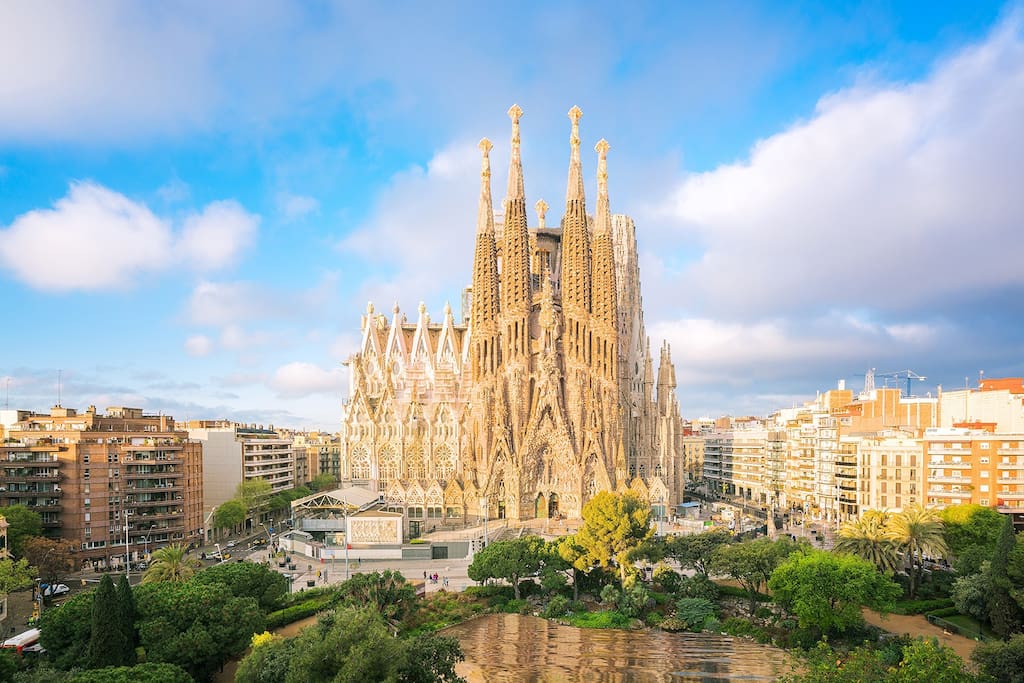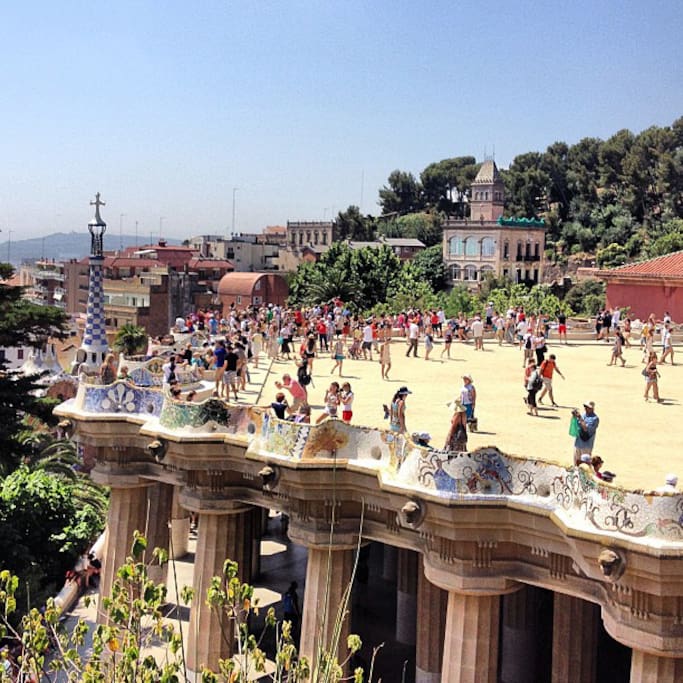Lugares emblemáticos
Don't forget to book your visiting tour and instal the app for your smartphone
3229 locals recommend
La Sagrada Cerveseria
16 Plaça Sagrada FamíliaDon't forget to book your visiting tour and instal the app for your smartphone
Don't miss one of the Gaudi House
https://www.casabatllo.es/venta-entradas/visita-noches-magicas/
1846 locals recommend
CASA BATLLÓ
43 Pg. de GràciaDon't miss one of the Gaudi House
https://www.casabatllo.es/venta-entradas/visita-noches-magicas/
You will discover that La Pedrera is a masterpiece of nature, the very essence of Gaudi’s work.
Accompanied by a guide, you will visit the Flower Courtyard, the Whale Attic hosting the Gaudí Exhibition and the Warrior Rooftop. Over the course of the tour, you will be able to watch a number of audio-visual presentations, culminating in the video mapping of the Roof-terrace of Gaudí’s building, which makes the most of the remarkable architecture of this space to take you on a journey back to the origins of life.
This unique visual show features multiple projections on the stairwells, special lighting and an accompanying soundtrack. And to bring the evening to a close, a glass of cava and sweetmeats.
Enjoy this totally unique and amazing immersive show at Casa Mila, one of the most iconic buildings in the city of Barcelona.
https://www.lapedrera.com/en/visits/la-pedrera-night-experience
1825 locals recommend
Casa Milà
92 Pg. de GràciaYou will discover that La Pedrera is a masterpiece of nature, the very essence of Gaudi’s work.
Accompanied by a guide, you will visit the Flower Courtyard, the Whale Attic hosting the Gaudí Exhibition and the Warrior Rooftop. Over the course of the tour, you will be able to watch a number of audio-visual presentations, culminating in the video mapping of the Roof-terrace of Gaudí’s building, which makes the most of the remarkable architecture of this space to take you on a journey back to the origins of life.
This unique visual show features multiple projections on the stairwells, special lighting and an accompanying soundtrack. And to bring the evening to a close, a glass of cava and sweetmeats.
Enjoy this totally unique and amazing immersive show at Casa Mila, one of the most iconic buildings in the city of Barcelona.
https://www.lapedrera.com/en/visits/la-pedrera-night-experience
The association between entrepreneur Eusebi Güell and architect Antoni Gaudí began when Güell saw a window display that Gaudí had planned for glove retailer Esteve Comella at the Universal Exhibition in Paris in 1878. That same year, Güell commissioned him to make the furniture for the pantheon chapel at the Palacio de Sobrellano in Comillas, a town on the Cantabrian coast, for his well-heeled father-in-law, Antonio López y López. The architect of that magnificent neo-gothic chapel was Joan Martorell i Montells, at whose studio Gaudí had worked.
Park Güell, © Col•lecció del Club Excursionista de Gràcia. Francesc Gassó. Gràcia District Municipal Archives
Park Güell, © Col·lecció del Club Excursionista de Gràcia. Francesc Gassó.
Gràcia District Municipal Archives
Some years later, Joan Martorell commissioned Antoni Gaudí with another project, thereby consolidating the association between the two architects. This time it was for the pavilions of the porter’s gatehouse and stables of Finca Güell (1883-1887), a property that the Barcelona businessman had in Les Corts, to the west of Barcelona.
Martorell, an architect enjoying great prestige at the time and whom Gaudí always considered to be his master, was a personality with a very decisive influence on his future production.
https://parkguell.barcelona/en/planning-your-visit/guided-tours
2138 locals recommend
Park Güell
The association between entrepreneur Eusebi Güell and architect Antoni Gaudí began when Güell saw a window display that Gaudí had planned for glove retailer Esteve Comella at the Universal Exhibition in Paris in 1878. That same year, Güell commissioned him to make the furniture for the pantheon chapel at the Palacio de Sobrellano in Comillas, a town on the Cantabrian coast, for his well-heeled father-in-law, Antonio López y López. The architect of that magnificent neo-gothic chapel was Joan Martorell i Montells, at whose studio Gaudí had worked.
Park Güell, © Col•lecció del Club Excursionista de Gràcia. Francesc Gassó. Gràcia District Municipal Archives
Park Güell, © Col·lecció del Club Excursionista de Gràcia. Francesc Gassó.
Gràcia District Municipal Archives
Some years later, Joan Martorell commissioned Antoni Gaudí with another project, thereby consolidating the association between the two architects. This time it was for the pavilions of the porter’s gatehouse and stables of Finca Güell (1883-1887), a property that the Barcelona businessman had in Les Corts, to the west of Barcelona.
Martorell, an architect enjoying great prestige at the time and whom Gaudí always considered to be his master, was a personality with a very decisive influence on his future production.
https://parkguell.barcelona/en/planning-your-visit/guided-tours
Eat Gaudí es un evento organizado por Anna Mollet y Mónica Masana.
Anna Mollet, gerente de la Torre Bellesguard, ha sido la impulsora de la creación del primer market gastronómico en una obra de Antoni Gaudí, un evento de marca propia, de periodicidad anual y con una firme vocación de permanencia en el tiempo.
Mónica Masana fue la primera profesional que organizó markets en nuestra ciudad hace más de 20 años con su potente marca Barcelona en las Alturas, que ya lleva más de 10 ediciones celebradas en la Torre Bellesguard.
Tenemos todo el know-how y la experiencia, pero también el talento, la perseverancia y la ilusión, para convertir este evento en una cita ineludible de la Ciudad Condal.
https://eatgaudi.com/
https://bellesguardgaudi.com/en/
39 locals recommend
Bellesguard
20 Carrer de BellesguardEat Gaudí es un evento organizado por Anna Mollet y Mónica Masana.
Anna Mollet, gerente de la Torre Bellesguard, ha sido la impulsora de la creación del primer market gastronómico en una obra de Antoni Gaudí, un evento de marca propia, de periodicidad anual y con una firme vocación de permanencia en el tiempo.
Mónica Masana fue la primera profesional que organizó markets en nuestra ciudad hace más de 20 años con su potente marca Barcelona en las Alturas, que ya lleva más de 10 ediciones celebradas en la Torre Bellesguard.
Tenemos todo el know-how y la experiencia, pero también el talento, la perseverancia y la ilusión, para convertir este evento en una cita ineludible de la Ciudad Condal.
https://eatgaudi.com/
https://bellesguardgaudi.com/en/
CASA CALVET
Este edificio modernista corresponde a la época naturalista de Gaudí, quien en 1900 recibió el primer premio del concurso anual de edificios artísticos de Barcelona. Está ubicado en el número 48 de la calle Casp, en el Eixample derecho. La principal característica de esta obra es su carácter conservador. Solo con echar un vistazo a su fachada se puede adivinar el autor de la obra. En ella están las formas características de Gaudí, que más tarde adquirirían cierta madurez; así como sus materiales más típicos: el ladrillo, la arenisca de Montjuic o el hierro forjado. En la ornamentación se presentan figuras naturales como setas, frutas o tórtolas; y no podían faltar el escudo de Cataluña ni las típicas cruces.
Parte del mobiliario de su interior se encuentra expuesto en la Casa-Museo Gaudí, situado en el Park Güell. Como curiosidad, la Casa Calvet superó en su día la altura permitida por el Ayuntamiento de Barcelona. Al parecer, el arquitecto lo sabía, aunque no quiso modificarlo.
https://www.barcelonaturisme.com/wv3/en/page/754/casa-calvet.html
Casa Calvet
48 Carrer de CaspCASA CALVET
Este edificio modernista corresponde a la época naturalista de Gaudí, quien en 1900 recibió el primer premio del concurso anual de edificios artísticos de Barcelona. Está ubicado en el número 48 de la calle Casp, en el Eixample derecho. La principal característica de esta obra es su carácter conservador. Solo con echar un vistazo a su fachada se puede adivinar el autor de la obra. En ella están las formas características de Gaudí, que más tarde adquirirían cierta madurez; así como sus materiales más típicos: el ladrillo, la arenisca de Montjuic o el hierro forjado. En la ornamentación se presentan figuras naturales como setas, frutas o tórtolas; y no podían faltar el escudo de Cataluña ni las típicas cruces.
Parte del mobiliario de su interior se encuentra expuesto en la Casa-Museo Gaudí, situado en el Park Güell. Como curiosidad, la Casa Calvet superó en su día la altura permitida por el Ayuntamiento de Barcelona. Al parecer, el arquitecto lo sabía, aunque no quiso modificarlo.
https://www.barcelonaturisme.com/wv3/en/page/754/casa-calvet.html
CASA VICENS
Fue una de las primeras obras de Antoni Gaudí tras haber terminado la carrera. El encargo le llegó de Manuel Vicens i Montaner, quien deseaba una segunda residencia en Gracia para pasar allí sus vacaciones, pues por aquel entonces, esta villa aún no estaba anexionada a Barcelona. Las obras comenzaron en 1883 y el autor siguió su estilo inicial, con influencias orientales: mudéjar, persa y bizantino. El resultado fue un edificio cubierto de cerámica que recuerda a las construcciones árabes. De hecho, en sus interiores, uno de los techos se asemeja al Generalife de la Alhambra de Granada.
Gaudí también diseñó su mobiliario y los jardines, aunque estos últimos hoy en día están ocupados por edificios de viviendas. En 2005 la Casa Vicens fue declarada Patrimonio de la Humanidad. Más información.
https://casavicens.org/
272 locals recommend
Casa Vicens
20-26 Carrer de les CarolinesCASA VICENS
Fue una de las primeras obras de Antoni Gaudí tras haber terminado la carrera. El encargo le llegó de Manuel Vicens i Montaner, quien deseaba una segunda residencia en Gracia para pasar allí sus vacaciones, pues por aquel entonces, esta villa aún no estaba anexionada a Barcelona. Las obras comenzaron en 1883 y el autor siguió su estilo inicial, con influencias orientales: mudéjar, persa y bizantino. El resultado fue un edificio cubierto de cerámica que recuerda a las construcciones árabes. De hecho, en sus interiores, uno de los techos se asemeja al Generalife de la Alhambra de Granada.
Gaudí también diseñó su mobiliario y los jardines, aunque estos últimos hoy en día están ocupados por edificios de viviendas. En 2005 la Casa Vicens fue declarada Patrimonio de la Humanidad. Más información.
https://casavicens.org/




